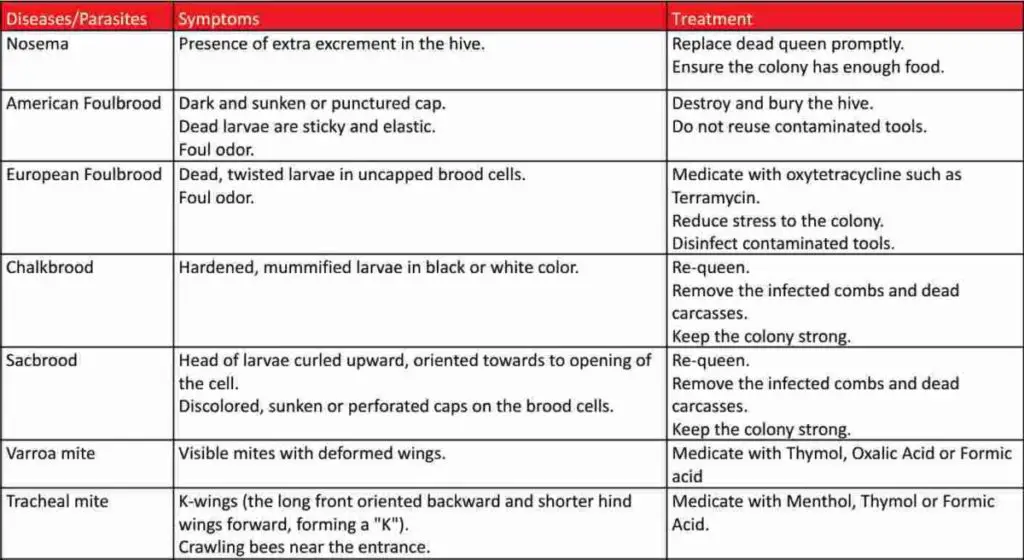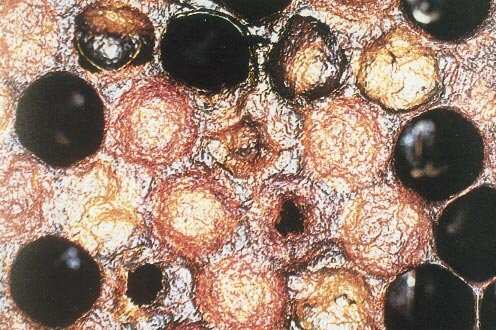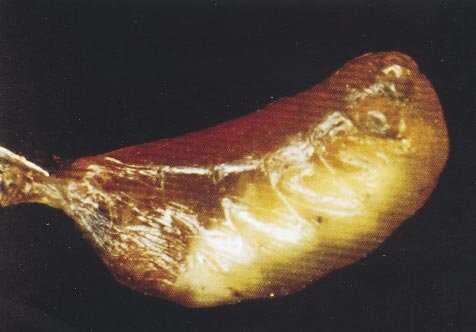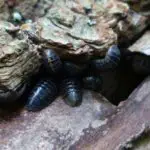Nothing is more heartbreaking for backyard beekeepers to see dead bees or failing bee colonies. In this article, we’ll go through the common diseases that affect bees, and how to deal with them.
Bees are susceptible to various diseases, which can be overwhelming for amateur backyard beekeepers. Surveys conducted by Bee Informed Partner show that backyard beekeepers experience 58.5% of colony losses between 2021 to 2022.
The reasons for bee colony losses can be attributed to diseases (parasites and pathogens), pesticides and poor nutrition. While the latter can be easily tackled, diseases are more fluid and hard to control, especially for backyard beekeepers who don’t have as much resources and knowledge as the commercial beekeepers.
Luckily, disease prevention in bee colonies has been well-studied. Backyard beekeepers can conveniently access the resources required to support the health of their bee colonies. In the next sections, we will go through the list of common bee diseases and how to deal with them.
Common Bee Diseases
Here is a snapshot of different bee diseases, their symptoms, and treatment methods. Some of them can be easily tackled by medications, while others require re-queening the colony, which is more complicated. You can refer to the my requeening guide for more information,

Nosema
Nosema is the most common honey bee disease encountered by beekeepers worldwide. It is caused by gut parasites Nosema ceranae and Nosema apis.
When the Nosema spores are ingested by the bees, they germinate and infect the guts of the bees. Then, they reproduce inside the bees, and more spores are generated and passed out in the bees excrement. When healthy bees clean the contaminated combs, they accidentally consume the spores, and become infected.
Nosema outbreaks usually happen in winter. During this time, the bees stay in the hive instead of foraging. They excrete their contaminated feces in the hive, which makes the disease spread faster.
Infected bees have a much shorter lifespan than healthy bees. On top of that, their ability to produce royal jelly is affected.
When the queen bee is affected, she produces less viable offspring. Eventually, she stops laying eggs, and dies within a few weeks.
A key Nosema symptom is the increase of excrements by infected bees due to dysentery. The bee colony dwindles, since the infected bees die faster than usual. They may die around the hive, or outside when foraging.
How to Treat Nosema
In the past, beekeepers treated and prevented Nosema with fumagillin. While commercial fumagillin is synthetic, it is a naturally-occurring compound.
Unfortunately, fumagillin is useful only for Nosema apis, but not Nosema ceranae, which is slowly displacing the former species.
The best way to treat Nosema for backyard beekeepers is by replacing the infected or dead queen promptly, and providing enough food for the colony. This will promote the growth of new broods to replace the infected bees. A strong colony will usually survive the winter outbreak, if they have enough honey reserves.
The key in Nosema treatment is to replace sick bees with healthy ones. Hence, you need to focus on driving brood production by ensuring you have a health queen and sufficient food.
Some beekeepers replace old combs with new ones every year. This reduces infection to some extent.
American Foulbrood

American foulbrood is a bacterial disease that can destroy the strongest bee colony. Infected broods succumbed to the disease at pupal or pre-pupal stage, making the colony collapse as the healthy bees die of age.
American foulbrood can be identified from the presence of dark and sunken or punctured caps on the brood cells. Dead immatures have sticky and elastic bodies that emit foul odor. You should be vigilant, and take note of those signs when carrying out your regular comb inspection.
How to Treat American Foulbrood?
The only viable treatment for American foulbrood is through medications such as oxytetracycline. However, it doesn’t work on the bacterial spores in the hive, which can remain dormant for years, and reinfect the bee colony. Hence, beekeepers often destroy the infested colony, and bury all the contaminated tools.
As soon as you identify an infection, you must deal with it immediately. Otherwise, your bees will spread the diseases to other hives within the community.
While medication can prolong the survivorship of your colony, it is not advisable, since the hive is already contaminated, and serves as the source of disease.
Equipment and tools used to handle infected bee colonies are contaminated with the bacteria. Make sure you don’t reuse them for other healthy bee colonies to prevent the spread of the disease.
European Foulbrood
European foulbrood is another bacterial disease that can affect a healthy bee colony. Fortunately, it is not as deadly as the American foulbrood, because this group of bacteria doesn’t produce spores.
The bacteria attack and multiply in the guts of the bee larvae. Infected larvae eventually die due to malnutrition, as bacteria compete for larval food, and emit foul odors.
European foulbrood can be identified from the presence of dead, twisted larvae in uncapped brood cells. The dead body slowly turns dark, and appears molten. It then dries up and sticks loosely to the cell wall.
Note that the dead bodies of infected larvae are infectious. When the bees clear out the dead body, they pick up the bacteria and contaminate other larvae.
How to Treat European Foulbrood
Treat European Foulbrood infected bee colonies with oxytetracycline, such as Terramycin. The risk of infection can be lowered by reducing the stress to the bee colony. Contaminated tools and equipment should be thoroughly disinfected before being used on healthy hives.
Chalkbrood
Chalkbrood is a fungal disease that weakens the bee colony by reducing its productivity and increasing its susceptibility to other diseases.
Infected larvae die in capped brood cells. They become hardened and mummified in black or white color. This is often visible when the bees uncap the brood cells. Dead bodies are usually moved to the floor or entrance to the hive.
If you shake the comb of an infested hive, you will hear the rattling sound of the mummified larvae in the brood cells.
How to Treat Chalkbrood
Quickly dispose of infested combs and mummified larvae to remove the source of infection. Re-queen the hive with a stronger stock if the infestation is severe. Keep the bee population strong by providing a suitable housing environment, and supplement food if required. A strong colony can fend off chalkbrood disease by itself.
Sacbrood

Sacbrood is a disease caused by viruses. It spreads in the hive through contaminated hive materials and carcasses of infected larvae.
Sacbrood disease can be identified from discolored, sunken or perforated caps on the brood cells. The affected cells contain infected larvae, which raise their head towards the cell opening in a unique posture before they die. The inner part of the carcasses liquify, forming a fluid-filled sac.
How to Treat Sacbrood?
Quickly dispose of infested combs to remove the source of infection. Requeen the hive with a stronger stock if the infestation is severe. Keep the bee population strong by providing a suitable housing environment, and supplement food if required. A strong and unstressed colony can fend off sacbrood disease by itself.
Varroosis
Varroosis is an infestation caused by varroa mites. Varroa mites are parasites that parasitize and suck the fat bodies of honey bees. While they don’t kill the bees, varroa mites weaken the bees, and reduce their lifespan and productivity. On top of that, varroa mites can transmit various diseases.
Varroa mite infestation can be easily identified from the presence of mites on the body of the bees. While they are tiny, varroa mites are large enough to be visible with naked eyes. On top of that, affected larvae may have deformed wings when emerging into adults.
How to Treat Varroa Mites?
Varroa mites can be treated by natural acaricides, such as formic acid, thyme oil and oxalic acid. They are usually incorporated in slow-release formulations, such as sachet or strips, to kill the mites, while being harmless to the bees. You can also use drone foundations to contain varroa mite infestation.
Varroa mites prefer to target drone broods, because the drones are larger, and can sustain more mites. You can get a drone foundation with larger imprinted hexagons. This will encourage the bees to build only drone cells on that foundation. As a result, the varroa mites are contained in that foundation.
Once you have multiple capped drone cells, remove the frame and freeze it for 24 hours or more. This will kill both the drones and mites.
After that, uncap the cells and put the frame back into the hive. The bees will remove the carcasses, and reuse the cells.
Repeat this process for a few rounds, and you will have the varroa mite population reduced.
Bear in mind that this will not eliminate the varroa mite issue. Instead, it reduces the level of infestation to an acceptable level.
Tracheal Mite Infection
Tracheal mites infection, also known as acarapiosis, is a deadly disease for honey bees, if not handled promptly. The mites infect the trachea of the bees, and suck their hemolymph (blood). Infected bees face breathing difficulties, reduced lifespan, as well as affected flight capability.
Unlike varroa mites, tracheal mites are so small that you can’t see them with naked eyes. So, how do you identify an infestation?
Tracheal mite infestation can be spotted by the presence of K-wings on the bees. This is where the long, front wings are oriented backward, while the shorter hind wings are oriented forward, forming a “K”. In heavy infestation, large amounts of bees are seen crawling around the hive entrance.
Because tracheal mite infection impairs the flight capability of the bees, foraging activities are markedly reduced. You will see more bees staying in the hive than a normal bee colony.
How to Treat Tracheal Mite Infection?
The best way to treat tracheal mite infection is by hanging menthol packets in the beehive for 2 weeks or more. The mites are killed when the tracheal mites are exposed to the evaporated menthol. Use it together with grease patties for additional protections. Grease patties alone will not resolve the issue.
The effectiveness of menthol treatment is temperature-dependent. Low temperature reduces the release of menthol, while high temperature forces the bees to stay outside the hive as the hive is filled with menthol. Mite-A-thol is an example of a menthol packet used to treat tracheal mite.
Menthol packets need to be hung for at least 2 weeks. This is because it takes 2 weeks for the tracheal mites to hatch from eggs and develop into adults. You might want to treat your hive for more than one cycle, since some mites may survive the treatment and reproduce.
On the other hand, grease patties work by making the bees greasy so that it is difficult for the mites to climb onto the bees. Grease patties can be made by evenly mixing 1 part of vegetable shortening with 8 parts of sugar. Extra grease patties can be kept in the freezer for future use.
To use the grease patty, simply place it above the frames of your beehive. The bees are attracted by the sugar, and some of them pick up the grease as they land on the patty.
Not all individuals in the beehive will visit the patty. And, not all body surfaces of a bee will be coated with the grease. Because of this, the grease patty cannot work alone if you already have a heavy mite infestation.
However, grease patties can work alone as a preventive measure if you don’t have an existing infestation. You can put the patty in the hive all year round. Replace the grease patty once it has been consumed.
Colony Collapse Disorder
On top of the typical diseases caused by known parasites and pathogens, honey bees can suffer from a phenomenon called the colony collapse disorder. While it is not a disease, it can be worse than that.
Colony collapse disorder is a phenomenon where most, if not all, adult bees, abscond the hive. They leave behind the capped honey, pollen, capped brood, and sometimes even their queen!
No one knows exactly what causes colony collapse disorder. Research has shown that stress caused by parasites, pathogens, and even pesticides may trigger this phenomenon.
If your hive is hit by colony collapse disorder, don’t be discouraged. Start a new colony and try to provide them better care. And don’t forget to extract all those honey left behind. They are safe for consumption.
How to Prevent Colony Collapse Disorder
Given the root cause of colony collapse disorder is unknown, there is no way to prevent them. Don’t get frustrated though, since you can reduce the chance of it happening.
In general, you can reduce the risk of colony collapse disorder by keeping your bee colony strong. Giving your bees sufficient ventilation and medication against diseases and food, can reduce the stress to the colony, and make it stronger. Reduce the use of pesticides, as they might trigger colony collapse disorder.
Colony collapse disorder is unpredictable. Although the number of occurrences has dropped, it’s better to be on the safe side by following good practices than otherwise.
While there is no direct link, it was found that the bees with colony collapse disorder have more pathogen loads. Hence, it is a good idea to medicate your bees and keep them healthy.
Similarly, it is suggested that beekeepers should not reuse the equipment used to handle bees suffering colony collapse disorder, as we are not sure whether it is contagious.
There are also numerous direct and indirect evidence pointing out that colony collapse disorder is associated with exposure to insecticides, especially neonicotinoids. Hence, it is always good to avoid insecticides, or at least minimize the usage, since exposure to insecticides also causes other effects, such as abnormal foraging activities and impaired brood development in bees.
How to Prevent Bee Diseases?
Bee diseases can be prevented by using disease-resistant stocks and following good beekeeping practices. While not all diseases can be prevented, adopting these approaches results in a stronger and healthier colony that can fight diseases on its own.
Disease-resistant stocks are harder to get sick. They are either genetically stronger in disease resistance, or they display superior hygienic behavior that helps them fight diseases.
For instance, the Buckfast is more resistant to tracheal mites than the Italian bees. If you want to have less headache dealing with diseases, choose those honey bee stocks with higher resistance towards diseases.
When to Medicate the Bees?
Certain bee medicines need to be administered through the syrup you provide to the bees. If medicated at the wrong timing and dosage, there may be residues in the honey harvest. Hence, it is important to use the medicine according to the manufacturer’s instructions.
The best time to medicate your bees is in the autumn and early in the spring or late winter. This is when your bees have the least capped brood, which ensures majority of your bees are treated. Moreover, because you don’t collect the honey in those periods, you will not risk contaminating the honey with the medicine.


